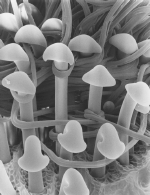From
Caterpillar to Chrysalis
Contributed by Dr. Lincoln Brower
Why does the monarch twist and turn so vigorously as the chrysalis forms?
Dr. Brower explains...
 |
|
|
1) Look at that little black post at the top under a microscope you'd see dozens of beautiful little hooks. As the chrysalid twists, this black post with barbed hooks are getting into the silk. If that little post doesn't get into the silk then the chrysalid will fall to the ground. And if it falls to the ground it will kill the chrysalid because at this stage the chrysalid is incredibly delicate and--it's really just almost a bag of fluid.
2) The second thing that is happening is that — if you watch (the video clip) really carefully — you'll see the larval skin — which now looks almost like a fly that slid up and up and up and up. The chrysalid has to get rid of that because if it doesn't it will stick to the surface and that will deform the butterfly. The butterfly would not be able to get out of its chrysalid unless it gets rid of its skin which messes up the metamorphosis process.





